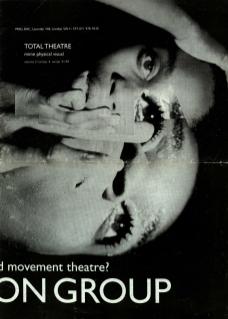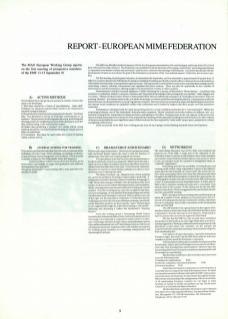The EMF was officially founded in January 1991 by four European representatives, Ide van Heiningen and Kootje Kruse (NL), David Ryan (UK) and Yves Marc (France). The Federation was established with the intention of becoming a united body ‘promoting international cooperation in the theatre of mime and movement’ and becoming a centre for the exchange of information. Concerned specifically with the development of mime as an artform, the goal of the Federation is promotion of the ‘non-material aspects’ of the form: the art must come first.
The first meeting of participants took place in Amsterdam this September, and was attended by approximately 60 people from fifteen different countries. It was based in the Felix Meritis Foundation's building (a building specifically created to offer a continuous focus on the initiatives of the intellectual and artistic avant-garde throughout Europe). The opportunity to meet had been created, thus undoubtedly providing valuable networking contacts, informal conversations and organised discussion sessions. There was also the opportunity to see a number of performances and demonstrations, offering insight into the development of mime in other countries.
Demonstrations included Gennady Bogdanov (USSR) examining the concepts of Meyerhold's ‘Biomechanics’ – a technique that examines coordination, rhythm, correction of posture and ‘the practical knowledge of the moving body as a machine’. Claire Heggen and Yves Marc, Théâtre du Mouvement (France), demonstrated their Decroux-influenced techniques of musicality of movement with very amusing ‘sketches’. A technique which seeks, not unlike choreology, to connect the aural and the oral using the physical. Contemporary work from Eastern Europe was demonstrated by a young Yugoslavian company. This raw production presented an angry and disturbing piece born from the extreme social conditions (as capitalism collides with communism and is fuelled by neglect) that these people now find themselves embroiled in.
Performances culminated with the entire group being driven to a train workshop in Haarlem for a ‘total experience’. Within this technological domain, one of the Netherland's foremost mime companies, Bewth physically moved the audience to different sets on a hydraulic seating block, manipulating working machinery and lighting to full effect, creating scenes in the vast expanse of the factory that had depth and perspective reminiscent of an animated Escher painting. Bewth specialise in taking movement theatre out of the confines of theatres and probably the most significant aspect of their work are the ideas inspired by the ‘ready-made’ props, space, perspectives, colours and lighting of the factory.
At the second day of the EMF, four working groups were set up to gauge current thinking and guide future developments.
A) ACTING METHODS
The Feedback from this group pinpointed a number of areas that need to be developed.
i) That there should be a fusion of specialisations – mime skill/technique (i.e., physical/corporeal mime) needs to be connected to emotion (acting technique).
ii) The production of relevant and communicative theatre – ‘Art for Art’s Sake’ – was dismissed in favour of work that communicates to an audience. The pros and cons of companies directing performing and devising need to be weighed up and out of this discussion arose the idea of there being a very real need for writers.
iii) Rather than producing a ‘product’ of a certain school, acting methods should be concerned with developing the unique personalities of individuals.
iv) Conclusion that mime be used within the context of training within a drama school.
B) AN IDEAL SCHOOL FOR TRAINING
This report concluded that an ideal school would incorporate all the techniques of voice, body, dance, painting, set-making, acrobatics, acting and mime, hence fusing these cross-art forms. (There actually is already a school in The Netherlands where this happens.)
Current problems within training show that students are far from ready to go straight on stage after graduation and sufficient development is not provided. The group proposed 6-7 years training with one year’s paid leave for teachers to study.
C) DRAMATURGY AND SCENARIO
This is a topic of great importance. The fusion of contemporary mime with text-based theatre means the need to find the function of dramaturgy: storylines and scripts alongside movement.
It is interesting to note that Decroux only intended mime to be silent until body control was mastered. Mime was in fact only a silent art form in times of political repression, and when sound was allowed back into film, then it was used. It was Decroux's intention that mime be used to recreate theatre; perhaps now there is more need than ever to develop his ideas.
The ideas of scenario – e.g. adaption from a book, painting, etc – poses the problems of having no initial script to work with. A feeling that we need to develop a shared vocabulary and language to ‘talk about mime’ emerged. Parallel to this development is the need to place work in a social context with improvisation, critical analysis, theme, meaning of movements, and a method of scripting movement and plot. From the working group came the recognition that there is no one dramaturgy, no one method of ideal approach which can determine how meaning is conveyed. This acceptance not only of the rightness, but the importance of, a plurality of viewpoints led the working group to the idea of a more utilitarian exchange, specifically on the important question: are there specific ‘mime’ dramaturgies? It was suggested this might be achieved by finding a ‘role model’ and dissecting and discussing it (rather like Rembrandt's ‘Anatomy Lesson’).
From this working group a Dramaturgy Model Project, funded by the Netherlands Mime Centre, has been implemented. Basically a comparative analysis study of a video tape containing a selection of mime, dance and performance pieces (plus additional material such as TV advertising and music videos and a detailed questionnaire). Segments of the video will then be analysed by working group members as to meanings, interpretations and dramaturgical elements.
D) NETWORKING
The networking discussion was led by MAG and examined the practical use of the EMF. A large part of the utilisation of the Federation is that it could be an information centre where members can research venues, festivals, media contacts, costs, sponsors, where to stay, etc and give scope for members to congregate under an ‘umbrella’ organisation.
Networking provides the possibility of raising finance and creating profile within a large organisation. It gives us the ability to assess areas for development on a macro scale. The actual role of a Euro-wide network will be born from the influences and ideas brought to the EMF from its members. Certainly the opportunities for continuing this valuable network are firmly rooted. MAG will operate as the UK representatives in the immediate future. It will be part of MAG's role to examine existing networks and to consolidate what already exists in this country as the Drama Year for the Arts 2000 project looms closer. 1994 was suggested as the year that MAG should host the annual EMF meeting.
With a European body promoting status and having recognition for a quality of work, perhaps we can at last move out of a decade of funding predominantly commercial viability, administration and packaging, and actually concentrate on the development of the artform itself.
The EMF intends to be a group based on the support of its members and as a democratic body each individual member’s input is important to feed the discussions of its directors. Membership is open to anyone who receives the approval of the Board.
The fact that the EMF has only recently been established means that it is still clearly at an early stage where there is scope for making suggestions. Meetings, publications and a support group with discussions would attract new members, yet the question left unanswered by the Amsterdam meeting is what will members get for their membership fee?
Your input is of major importance, especially during these formative stages. We need to let the EMF know what we want and consider as priority needs for European cooperation.
Unfortunately not all European countries were present at this first meeting (Spain, Italy and Portugal were not present and there were only a few Scandinavian representatives). However, since the last meeting of the board, European countries not represented will be brought into membership.
Membership contributions, after some discussion, have been set at the following levels:
1) Institutes & Organisations - $500
2) Schools, companies, educational institutes - $250
3) Personal members - $100
A firm financial situation is imperative to its development; it is essential that you support this radical development now. An initial investment from mimes in Britain will enable the EMF to play a major role in the future development of mime theatre throughout Europe. With a better understanding of the totality of the work and aims of all participating European countries we can begin to make headway in raising our profile and perhaps one day see the need created for an International Mime Federation.

